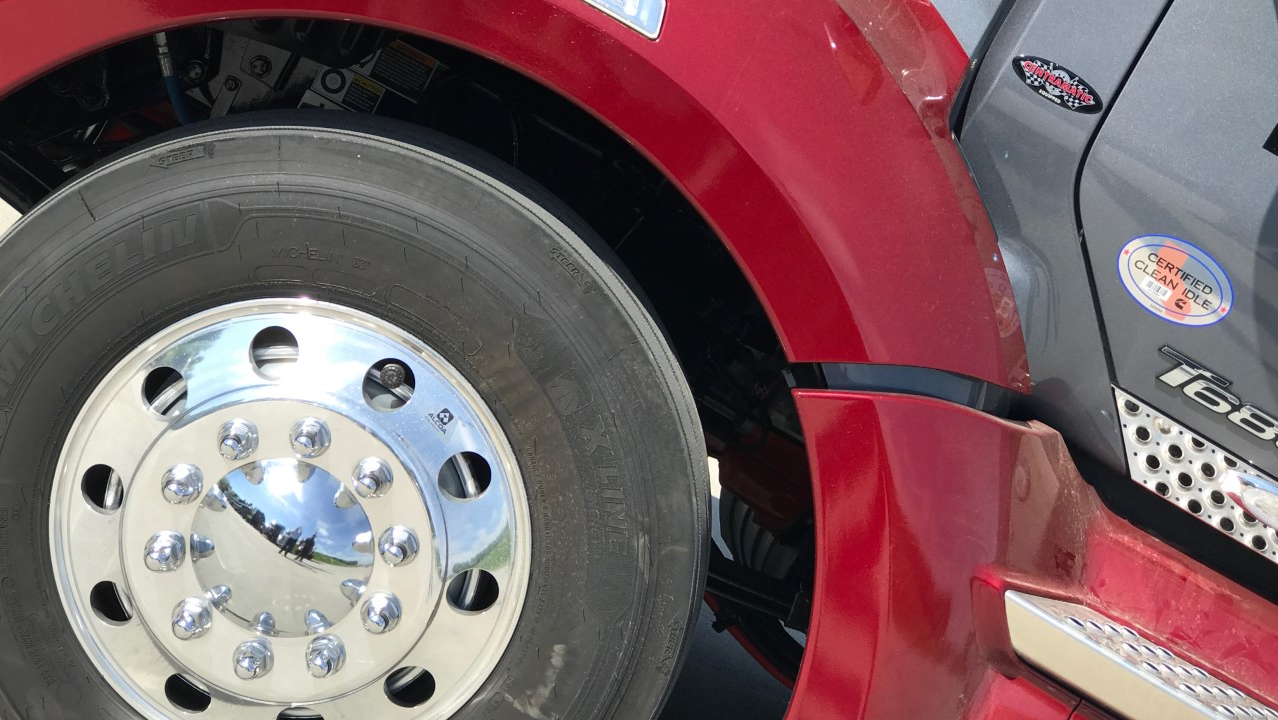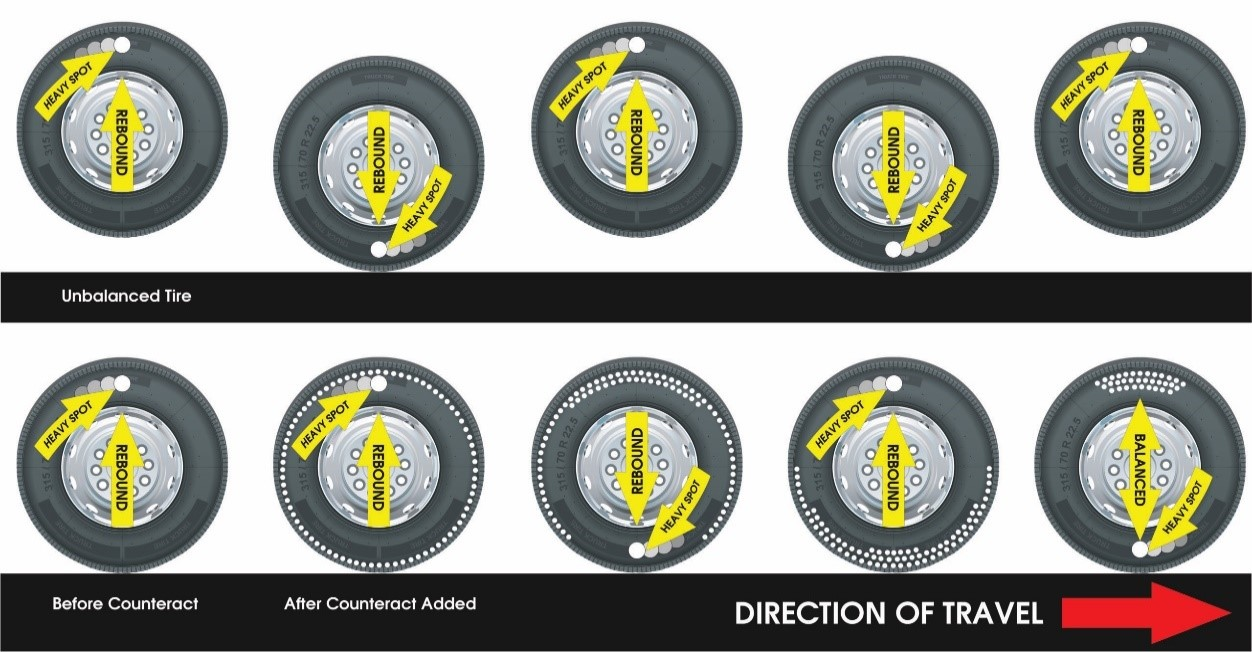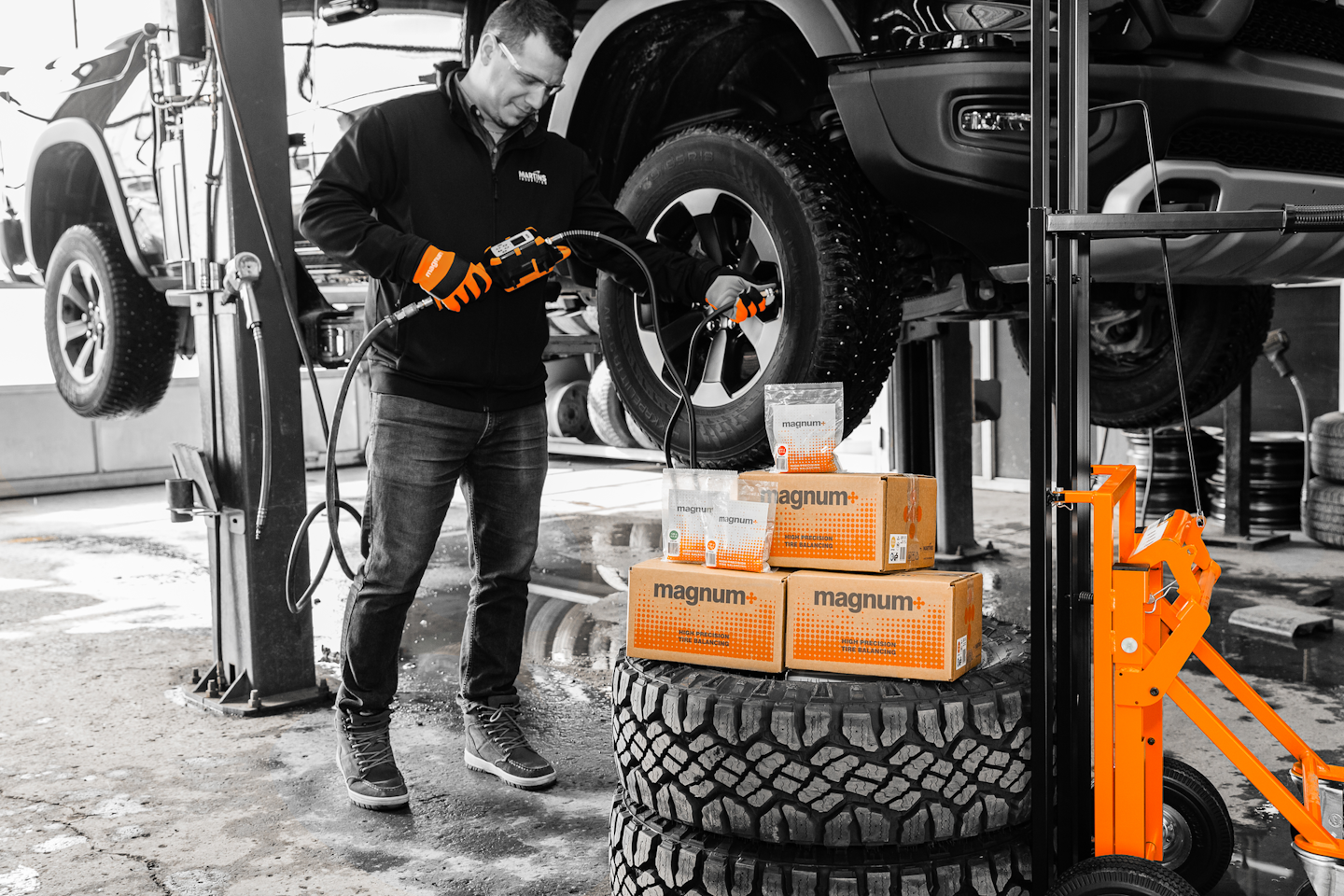From wheel weights and internal compounds to balance rings, how to decide which options are best for your fleet.
An out-of-balance tire not only causes driver discomfort but can also lead to lower fuel economy, mechanical failures, and reduced tire life. Tires already present one of the highest expenses for fleets, so getting the most out of the investment is a main priority for many fleets.
It is important to review the benefits of balancing tires regularly and the different methods to do so.
There are several options available that allow fleets to balance tires without removing them from the truck or trailer: the traditional method of attaching external weights to the wheel’s rim, using internal balancing compounds, or mounting balance rings behind the wheel.

Centramatic On-Board Wheel Balancers offers several sizes depending on make, model, year, wheel size, and wheel position for a secure fit.Photo: Centramatic
Why balance?
According to Technology & Maintenance Council (TMC) Recommended Practice (RP) 214, Tire/Wheel End Balance and Runout, there are several benefits to regular tire balancing. These benefits include increased driver satisfaction and comfort through improved vehicle ride, reduced irregular tread wear, reduced fatigue stress of components, increased life of axle end components and steering assemblies, and extended tire removal mileage.
“If a fleet ignores tire imbalance issues, irregular and/or fast wear will occur and that can mean ride disturbance and vibration – something your drivers won’t like,” says Phil Mosier, manager of commercial tire development at Cooper Tires, a manufacturer of commercial vehicle tires. “Gone unchecked, it will also mean you’ll have to remove tires early in life, and that has a direct impact on your overall tire budget. If a tire imbalance is severe, it could eventually damage vehicle mechanical components, so the fleet not only loses money on the tire from being removed early due to irregular wear but the tractor may end up needing additional mechanical work done.”
For Mike Steiner, customer engineering support referent for tire manufacturer Michelin North America, the most important consideration is driver dissatisfaction.
“They are just not happy; they have to sit in the truck for hours and have to put up with the shaking,” he says, of drivers operating vehicles with out-of-balance tires. “The bad thing about most vibrations that come from [tire] balance is they tend to be at a speed that you sometimes have to spend a lot of time in. Trucks will typically vibrate between 52 and 60 mph, depending on the size of the tires, so of course, that’s an area where they have to spend a lot of time and no one wants to sit there and feel the truck shake for a long period of time.”
When balancing tires, all tires should be balanced, not just the steer tires.
“It’s common in the industry to hear fleets say they only balance the steer tires because that is all you’re going to notice,” says Grey Meyer, product manager of wheel balancers at Hunter Engineering, a tire and wheel service equipment manufacturer. “But you’re missing out on a big part of the tire’s life situation. All the tires need to be checked.”
All tires should be balanced to maximize ride comfort and ensure long life and optimum fuel economy, Mosier adds.
Another consideration is the type of imbalance tires are experiencing. When it comes to commercial vehicles’ tires, there are two types of imbalance: static and dynamic.
Static imbalance occurs when the heavy spot of the tire falls to the bottom, causing the wheel to shake and hop up and down.
“If you give [the tire] a spin, the heaviest part of the wheel and tire is always going to go down to the six o’clock position,” says Kyle Harris, product marketing manager at Hennessy Industries, a manufacturer of wheel service equipment, accessories, and consumables.
When the tire has more weight on the inside or outside of its tread, dynamic imbalance occurs, causing a side-to-side shake.
On-tire balancing
A number of methods can be used to balance heavy duty vehicle tires without removing the tire and wheel assembly from the vehicle. These options include wheel weights, internal balancing compounds, and balance rings.
Wheel weights
Attaching external wheel weights to the rim in order to correct tire imbalances is one of the oldest methods to balance tires and is still commonly used today.
Wheel weights attach to the wheel rim flange or other locations on the wheel rim surface to offset an unequal distribution of weight from the tire.
There are two different types of wheel weights: tape-on (also known as stick-on) and clip-on.
Tape-on weights use adhesive to stick onto the wheel’s rim, whereas clip-on weights clip onto the outside of the wheel.
Up until the last decade, lead wheel weights were most commonly used. Due to environmental concerns, the industry is moving toward using zinc and steel wheel weights.
“Lead weights are definitely going away from an environmental standpoint; several states have released anti-lead legislation,” Hennessy Industries’ Harris says.
It’s not illegal to buy lead wheel weights, he notes. However, in some states it is illegal to install them.
“More and more states are going to either steel or zinc weights … [as they] are more environmentally friendly,” Harris adds.
There are several benefits to using wheel weights. They can be installed on all tires, including trailer tires, and they come in several profiles to fit the different styles of wheels and edges. They can also correct both static and dynamic wheel balancing.
To correct static imbalance, Harris says to hang one single wheel weight to counter the imbalance.
“I recommend that this is hung somewhere in the middle of the wheel between the inboard and outboard side of the wheel if you are using a tape weight, otherwise if you are using a clip weight, it can go on the outboard plane or the inboard plane,” he says.
To solve dynamic imbalance, technicians should hang two rows, or “planes,” of weights on each wheel, Harris advises. One on the inboard side of the tire and one on the outboard side.
“A dynamic balance essentially corrects for side-to-side imbalance (couple) and static forces (up and down),” Harris says.
Though wheel weights should last the life of the tire, they could potentially fall off if not properly installed or when driving over rough roads. If the wheel weights do fall off, they are typically unable to be reinstalled, especially tape-on weights.
If wheel weights are not installed correctly, they will not solve the imbalance issue, and a wheel balance machine, or other balancing method, may be needed.
Internal balancing compounds
Another on-tire balancing method is to use a free-rolling compound within the tire which moves as the assembly rotates, keeping the tire in-balance by offsetting the heavy spots.
Internal balancing compounds typically come in pre-measured bags and are placed inside a tire during installation or dismount. The bags break open and disintegrate once the tires start to rotate. As the truck picks up speed, the heavy spots of an unbalanced wheel assembly will pull up and down, forcing the material to shift and alter its position within the tire through centrifugal force. The material will end up on the opposite side of the heavy spot, counteracting the imbalance of the tire.
Some internal balancing compounds can also be injected directly into the tire through the valve stem, eliminating the need to remove the tire from the vehicle altogether. Counteract Balancing Beads, for example, can be installed either by a pre-measured bag and tossed in the tire when dismounted or alternatively can be installed via the valve stem by using an injection pump.
Essentially, internal balancing compound re-balances the assembly each time the vehicle is in motion.

Counteract illustrates the difference on an unbalanced tire before and after balancing beads were installed.Photo: Counteract
The type of material varies by manufacturer. For example, Magnum+ balancing beads from Martins Industries and Counteract’s balancing beads are made of tempered glass, while tire maintenance and wheel safety provider IMI’s Equal Flexx balancing material mixture is made of plastic and soft rubber compounds.
Internal balancing compounds can also help alleviate uneven tread wear by continually balancing the tire and wheel assembly during each rotation.
“The tire is kept in balance regardless of the condition of the tread,” say experts at Counteract, a manufacturer of tire balancing beads. “While the beads will not prevent wear caused by external factors such as misalignment, they will mitigate additional wear resulting from imbalance as tread rubber is scrubbed away. This is especially beneficial with tires that have been repositioned to drive or trailer positions to run out prior to retreading.”
 Incorporating balancing methods and procedures into preventative maintenance programs, as well as inspecting tires and wheel-end components, will help fleets prevent balancing issues and help mitigate future expenses.Photo: Magnum+, a Martins Industries brand
Incorporating balancing methods and procedures into preventative maintenance programs, as well as inspecting tires and wheel-end components, will help fleets prevent balancing issues and help mitigate future expenses.Photo: Magnum+, a Martins Industries brand
Internal balancing compounds can be used on all tire positions, improve vehicle ride, last the life of the tire, can be reused, and eliminate the need to keep inventory of different sizes of external wheel weights. They also correct both static and dynamic imbalances.
Chris Pourroy, director of national accounts at IMI, says Equal Flexx also addresses tangential fore-aft (backward/frontward) forces, as well as changes in the tire’s footprint resulting from changes in speed, load, or road conditions, known as road force variations. For example, when hitting a pothole or rumble strip in the road, a portion of Equal Flexx stays in the footprint of the tire, dampening the impact like a dead blow hammer.
Isabelle Oliver, marketing product manager at Magnum+, a Martins Industries brand, also notes that “[external wheel] weights only balance tires based on their condition at a fixed point in time and as they wear, their balancing requirements change, meaning the original fixed weights no longer provide a proper balance.”
Since internal balancing compounds re-balance each tire whenever the vehicle is driven, technicians don’t need to dismount tires or place them on a computer wheel balancer for inspection.
Although there are many benefits to using internal balancing compounds, fleets should be sure to thoroughly research and test the products before implementing.
TMC RP 214 advises fleets to verify that the product will not affect either the tire or wheel warranty, as well as assure the materials are non-corrosive and non-abrasive to tire liners and wheel surfaces. The RP also notes that balancing materials can clog valve cores and create leaks and that some materials are sensitive to moisture.
Balance rings
Installed between the brake drum and hub and the wheel, balance rings are another method used to balanced tires while on the vehicle.
Balance rings are filled with either free-moving liquid or small metal balls and use centrifugal force – similar to internal balance compounds – to automatically balance the tire and wheel as it travels down the road.
Bob Jessee, regional manager at Centramatic, a hub and wheel balancer manufacturer, describes their On-Board Wheel Balancer as a “once and done” approach. Once installed behind the wheel, balancing is permanent, he states.
 Centramatic On-Board Wheel Balancers are installed behind the wheel, as shown.Photo: Centramatic
Centramatic On-Board Wheel Balancers are installed behind the wheel, as shown.Photo: Centramatic
To install, the balance ring goes on before the wheel and is mounted the same way.
Centramatic’s balancing rings can be installed on all wheel positions and offer several part numbers depending on the make, model, year, wheel size, and wheel position, for a secure fit. The balance media inside consists of small metal balls, the size of BBs, in oil. Depending on the tire position, the amount of balancing media inside the device varies.
“The steer balancer, depending on the part number, has between 12 and 16 ounces of balancing media inside it,” Jessee notes. “The drive and trailer balancer that is installed between the duals has about 32 ounces of balancing media inside.”
The benefits of balance rings are many, according to Jessee, noting that fleets have reported a 25 percent increase in tire life for their steer tires, 35 percent increase for drive tires, and often more than 50 percent for trailer tires.
When considering balance rings, fleets should ensure the proper size ring is used, no damage is made to the front of the ring, and that it doesn’t interfere with the brake drum or wheel. Loose wheels or tire damage may result.
Best practices
In order to prevent tire imbalance, fleets are advised to balance all tires regularly.
Tire balancing is typically not included in most fleets’ preventive maintenance programs, and it is ultimately up to the fleet when – or if – they check for imbalance. This is usually done when installing a new tire or after an imbalance issue has already been reported.
“When a brand new tire is put on, a lot of manufacturers will say it doesn’t need to be balanced, but when you put that tire on the wheel, and when you put that tire and wheel assembly onto the truck, there are a lot of variables that [can] potentially go wrong or have issues,” says Bob Bortner, territory manager at IMI.
Over time and miles, balance changes. Tire wear is inevitable due to excessive load, scrub, rough roads, etc. Bortner says a tire will lose about 26 to 30 lbs of rubber on average over its life, so it’s important to regularly rebalance.
“The first balance is good, but unless you’re going to bring that tire back and rebalance at certain points throughout its life, the first result was a wasted effort and ultimately a cost,” IMI’s Pourroy adds.
Incorporating balancing methods and procedures into preventive maintenance programs, as well as inspecting tires and wheel-end components, will help fleets prevent balancing issues and help mitigate future expenses.
Conclusion
Keeping tires balanced is important for a fleet not only for the driver’s comfort, but also for factors such as fuel economy, tread wear, and wheel-end component longevity. But, the best method to do so may be different from fleet to fleet, depending on the fleet’s vehicle type, duty cycle, and personal preference.
“One of the largest operating expenses a commercial vehicle fleet will incur is the cost of its tires,” experts at Counteract say. “This is due to not only the cost associated with new tires and labor but the downtime caused by unnecessary tire replacements. By [practicing] regular and consistent rebalancing, a fleet can prolong the life of their tires and avoid exorbitant costs.”
Source: https://www.fleetowner.com
CUT COTS OF THE FLEET WITH OUR AUDIT PROGRAM
The audit is a key tool to know the overall status and provide the analysis, the assessment, the advice, the suggestions and the actions to take in order to cut costs and increase the efficiency and efficacy of the fleet. We propose the following fleet management audit.




